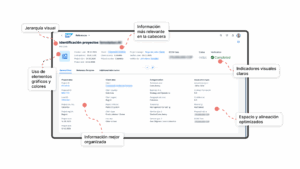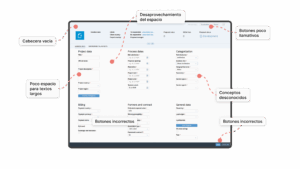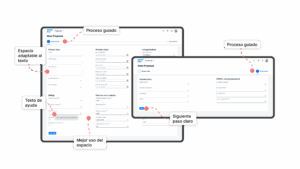CONSULTING
Transforming SAP S/4HANA from the user experience
Irene de Elejoste Orcajada
Digital transformation consultant | Linkedin
At IDOM, we are immersed in a digital transformation process that extends well beyond technology. From the SAP consulting area, we are spearheading an internal initiative to optimize our business processes by putting our users, who rely on them the most, at the center.
Alongside a team of developers, we are working to make the SAP business module more intuitive, efficient, and user-friendly. Our goal is clear: to ensure that every interaction with the system is a positive experience that facilitates daily work and boosts productivity.

UX design involves thoroughly understanding user needs and business objectives, and building solutions that effectively address both.
What exactly is UX design?
User experience (UX) design is more than just creating visually appealing screens. It involves thoroughly understanding user needs and business objectives and building solutions that effectively address both.
At IDOM, we apply the classic UX model, which is structured into five levels:
- Strategy: What does the user need? What is the business looking for?
- Scope: We define the key functionalities that the system must offer.
- Structure: We organize information in a logical and accessible way.
- Skeleton: We design interactions and navigation to feel natural.
- Surface: We take care of visual aesthetics to reinforce usability.
This approach enables us to develop solutions that are both functional and enjoyable to use.
SAP Fiori offers a new way of interacting
It allows us to apply these principles in SAP environments, offering modern, adaptable, user-centered interfaces. At IDOM, we use SAP Fiori to redesign key processes, such as creating offers and managing project references.
To illustrate this, let’s consider our project reference application:

Figure 1 – Before: Cluttered screens, no visual hierarchy, disorganized information.

Figure 2 – After: Clear design, use of icons, better alignment, and guided navigation.
Another area we have improved is our proposal creation process:

Figure 3 – Before: Confusing flow, frequent errors, unintuitive fields.

Figure 4 – After: Step-by-step guided process, explanatory fields, clean interface.
Designing user-centered applications requires an iterative process in which each improvement is validated and adjusted based on feedback. While changes can be made directly in development environments, this can be time-consuming, especially when redesigning entire flows or testing new interactions.
At IDOM, we use Figma, a collaborative design and prototyping platform, in conjunction with SAP’s low-code solutions based on SAP BTP Build to streamline this process. Figma enables us to create interactive prototypes that simulate real user experience. This facilitates early validation of ideas and reduces the number of adjustments needed in later stages.
After the design is defined, the development team implements it using BTP Build’s capabilities. This allows us to maintain visual and functional consistency, accelerate delivery times, and minimize technical effort.
The real-world advantages of UX design
Investing in UX from the outset has a direct impact:
- Fewer errors: Clear, well-structured interfaces help users understand how to use applications better, which reduces common errors. This improves work quality and lowers the cost of corrections and rework.
- Higher productivity: When solutions are intuitive and efficient, users can complete their tasks faster and with less effort. This frees up time to focus on strategic, higher-value activities.
- More satisfied users: A positive experience leads to greater satisfaction, resulting in a more favorable attitude toward the tools, increased adoption, and loyalty.
- Reduced training and support costs: Intuitive interfaces require less time to learn and less technical assistance, which significantly reduces the resources dedicated to training and support.
- Greater motivation and autonomy: Users are more motivated and autonomous when they are comfortable with the tools, which improves their performance and commitment.
- Continuous improvement based on real feedback: Involving users in the design process enables the identification of needs and problems early on, facilitating agile adjustments and preventing minor issues from becoming significant barriers.
Looking to the future
We are increasingly incorporating UX design as a cross-cutting strategy in our projects. This strategy is not limited to internal initiatives; we also apply it to client developments as part of our value proposition. This approach enables us to develop more efficient and intuitive solutions that align with the genuine needs of users and businesses.
Good design from the beginning improves the experience and reduces costs and development time by avoiding subsequent corrections. At IDOM, we are committed to people-centered design as a driver of transformation because UX design is not just a project phase; it’s a mindset and approach to working and building effective technology.



